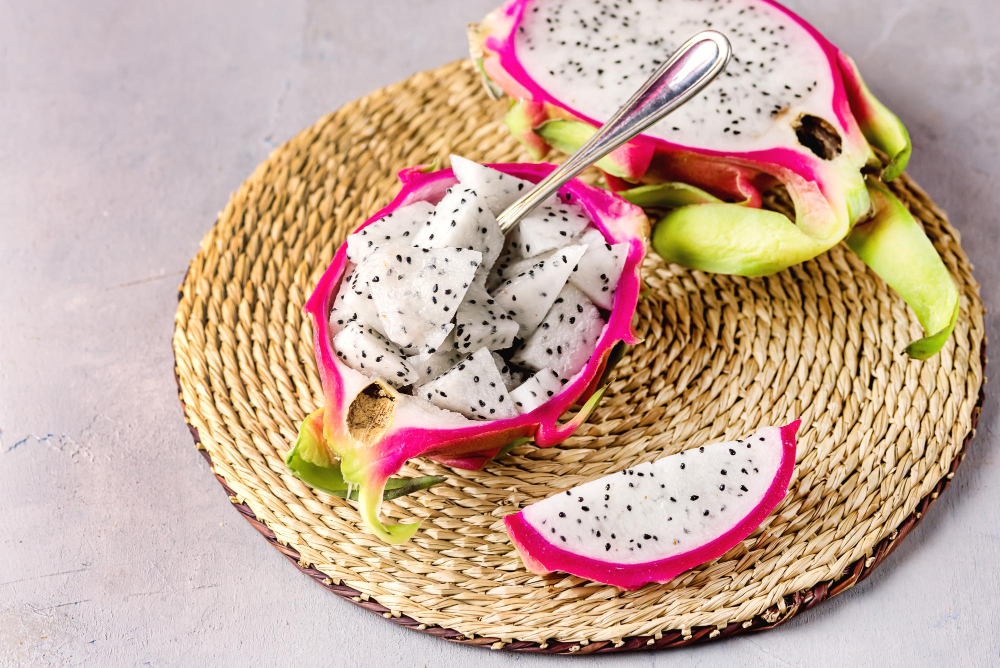Dragon fruit doesn’t contain latex—at least, that’s what recent studies indicate. So you can freely consume this fruit without worrying about latex allergy. You may also want to know if does dragon fruit contains vitamin K and does dragon fruit contain lectins for additional insights.
Having a latex allergy might be made worse by eating certain vegetables and fruits because they contain proteins with a structure similar to latex. Because of this, people who are allergic to latex have symptoms.
Although latex is not found in many foods, proteins that are comparable to latex are. Therefore, an individual with a latex allergy may experience an allergic reaction if they consume food containing these proteins.
Those who have an allergy to the proteins in natural rubber latex have an IgE-mediated latex allergy. This is because your immune system produces antibodies known as IgE antibodies. Allergic reactions to latex are caused by antibodies that bind to proteins in the material.
Those who are allergic to latex may also experience responses when eating specific fruits and vegetables. Thirty-five percent to fifty percent of patients with latex allergies experience these symptoms.
The physician will inquire about your health information and perform a physical examination to determine if you have a latex allergy. In addition, there are allergy skin tests, and blood tests can be administered if your doctor suspects a latex allergy.
Cross-reactive foods are dangerous, so it’s best to avoid them if you can. For example, a person with a latex allergy must avoid eating cross-reactive food after it has been detected.
Do Dragon Fruits Contain Latex?
Even though few foods contain latex, several have chemically similar proteins found in latex. The proteins in question may trigger an allergic reaction in people who are sensitive to latex if they eat foods containing them. Latex cross-reactive meals are what they sound like.
When it comes to potentially harmful cross-reactive foods, prevention is everything. For example, if a person with a latex allergy learns that a particular food triggers a reaction in someone who isn’t allergic, then that person should avoid eating that item.
This is because certain people have allergies to dragon fruit and should stay away from it. As allergic reactions to dragon fruit can include swelling of the lips and tongue, an itchy throat, a burning sensation in the throat, and similar symptoms, consuming it when you are sensitive would be counterproductive.
It’s possible that dragon fruit can be included in a low histamine diet. However, take great care with dried fruits, which often include stabilizers like sulfur dioxide or sulfites.
The skin of the dragon fruit is safe to eat. After a thorough cleaning, the skin of dragon fruit is safe to consume and beneficial to your health. Scrub your dragon fruits using a vegetable scrub if they’re too grimy to eat.
The fermentation process gives the dragon fruit enzyme 3.6% alcohol, which results in a warming effect upon consumption. This is because halal certification is only awarded to products with an alcohol content of 0.5% or less, which the dragon fruit enzyme does not.
Which Fruits Are High In Latex?
Latex is a type of natural rubber harvested from the Brazilian rubber tree sap, which grows in tropical regions of Africa and Southeast Asia. Anyone with an overly sensitive immune system may develop a latex allergy if they contact with any of these materials.
Some people have a latex allergy because they eat fruits and vegetables whose proteins have the same structure as latex. People who are allergic to latex respond negatively to this.
It’s not just eating certain foods that might set off an allergic reaction; even handling or smelling them can trigger symptoms. For example, some fruits and vegetables might cause responses in those allergic to latex.
What Foods To Avoid If You Have A Latex Allergy?
Even though few foods contain latex, several have chemically similar proteins found in latex. The proteins in question may trigger an allergic reaction in people who are sensitive to latex if they eat foods containing them. Latex cross-reactive meals are what they sound like.
When it comes to potentially harmful cross-reactive foods, prevention is everything. For example, if a person with a latex allergy learns that a particular food triggers a reaction in someone who isn’t allergic, then that person should avoid eating that item.
This does not suggest that any of these foods are tainted with rubber. However, since an immune system’s essential basis of identification is the surface molecules, the likeness between the two enables the body to misidentify these meals as latex, creating an allergic reaction.
Is Dragon Fruit A Common Allergen?
The antioxidants in dragon fruit, including vitamin C and other phytonutrients, polyphenols, and carotenoids, are responsible for many of the fruit’s purported health advantages. However, not everyone has the same chance of enjoying these advantages.
- Dragon fruit is known for lowering hypertension and high blood pressure, but overeating it at once could lead to a potassium overload and a consequent reduction in blood pressure. Hypotension, or low blood pressure, is characterized by various symptoms, including but not limited to nausea, sleeplessness, exhaustion, sadness, and even loss of consciousness.
- Those with dragon fruit allergies should remain well away from the fruit. Severe allergic reactions to dragon fruit include lip and tongue swelling, itchy throat, burning sensation in the throat, and other symptoms.
- Though dragon fruit is known for lowering hypertension and high blood pressure, consuming too much at once could lead to a potassium overload and a consequent reduction in blood pressure. Hypotension, or low blood pressure, is characterized by several symptoms, including the inability to sleep, nausea, weakness, depression, and even temporary or permanent loss of consciousness.
- Overconsumption of dragon fruit, which is rich in antioxidants like beta-carotene, has been associated with an increased risk of lung cancer. And there’s more: higher vitamin E intake is linked to a higher risk of bleeding-related stroke.

